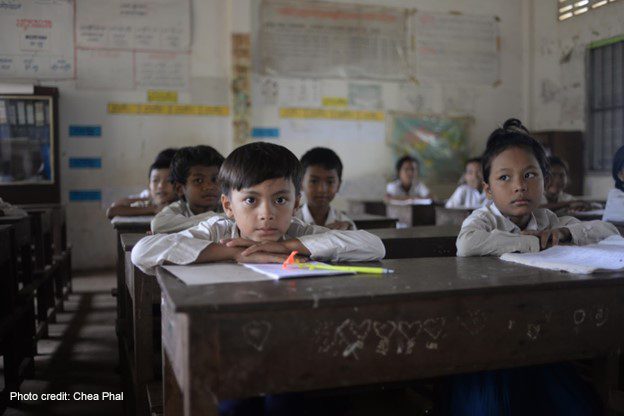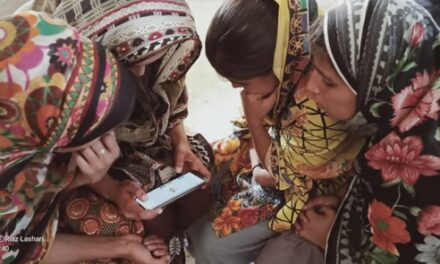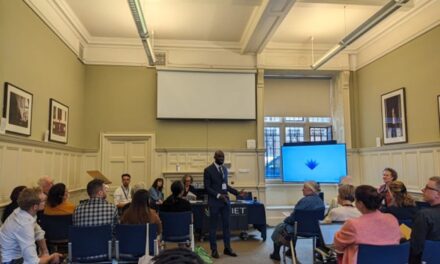This blog was written by Sorsesekha Nok and Leanne Cameron. Sorsesekha is a research assistant at Centre for Educational Research and Innovation of the Cambodia Development Resource Institute. She is now on her study leave pursuing her master’s degree at Lund University, Sweden. Her research interests encompass topics such as gender in education, general and higher education development, learning and teaching assessment, the economics of education, and sustainable development. Leanne Cameron is a Senior Consultant at Education Development Trust with experience as a researcher, practitioner, and education advisor focused on the improvement of education systems and development of teachers in low- and middle-income contexts. For the 2023 UKFIET conference, 28 individuals, including Sorsesekha, were provided with bursaries to assist them to participate and present at the conference. The researchers were asked to write a short piece about their research or experience.
In the realm of education, the perpetuation of gender norms and stereotypes has long been a concerning issue: classrooms can be unequal places where genders are treated unequally and only some are provided with opportunities to learn and lead. However, there is a glimmer of hope in the form of Gender-Responsive Pedagogy (GRP). GRP focuses on tailoring teaching and learning processes to address the needs of girls and boys while putting an end to the transmission of gender bias (Chapin & Warne, 2020). The results of GRP are promising, with evidence demonstrating the potential for increased learner activity, enhanced self-esteem, and transformational experiences for teachers (Coffey, 2017; GEC, 2018; Rose, et al., 2021; Wanjana & Njuguna, 2016). Moreover, GRP contributes to improved learning outcomes and empowers both girls and boys within the educational sphere (UNESCO, 2019).
Cambodia’s educational landscape reflects this global commitment to gender equality. The country has taken significant strides in promoting gender equality in education over the past 25 years (Hunter, 2022). Cambodia has ratified key international human rights treaties, such as the Convention on the Elimination of All Forms of Discrimination against Women (CEDAW). In response to global sustainable development goals, Cambodia has developed Gender Mainstreaming Strategic Plans (2021-2025) in collaboration with the Ministry of Education, Youth, and Sport (MoEYS). Along with this policy, various initiatives are taking place to promote equitable access to education. For instance, one government strategy provides scholarships for poor students in order to increase girls’ enrolment rate, particularly at secondary level. Taken altogether, these strategic plans aim to ensure equitable and inclusive access to educational services for all, regardless of gender.
This blog post summarises key findings from recent research conducted by the Cambodia Development Resource Institute (CDRI) and Education Development Trust which investigates Cambodia’s journey toward gender-responsive education. Gender-Responsive Pedagogy, using FAWE’s (2018) framework, provides a lens for examining changes within Cambodian classrooms as reported in key informant interviews. Our analysis focused on key GRP components including teaching and learning materials, language use, classroom organisation, classroom management, and addressing gender-based violence.
- Teaching and learning materials: Materials used in the classrooms can limit the professional and personal roles that children of both genders are exposed to and thus envision for themselves. In Cambodia, interviews noted that significant effort has been made to eliminate gender stereotypes from teaching and learning materials. Before publication, the teaching materials need to go through MoEYS’s gender committee to ensure they are gender-responsive. While this is a positive development, it is essential to acknowledge that not all materials can be made entirely gender-neutral. Some content may still reflect societal norms and traditions.
- Language use: Language plays a pivotal role in shaping perceptions. Although language use has been integrated into the teaching curriculum, it is not always effective. While many teachers now understand the impact of their words on students’ well-being and academic achievement, some old habits persist. For instance, in some educational settings, some older teachers may employ impolite language by using words like “Anh,” which translates to “I” in Cambodia. This language choice can have a significant impact on the classroom dynamics, creating a noticeable hierarchical structure. When teachers use such terms, it implies that they are elevating themselves above the students. In essence, it suggests a sense of superiority, as if they consider themselves more important or authoritative than the others present in the classroom.
- Classroom organisation: Classroom organisation encompasses both seating arrangements and decoration. When it comes to seating, there is a lack of official guidelines, leading to differences between teachers and schools. The concept of gender-responsive seating, where both boys and girls sit together, has demonstrated its positive influence on students’ self-confidence. However, this approach faces hurdles, as certain parents resist it due to ingrained traditional norms. Another area, classroom decoration, plays a pivotal role in fostering gender equality. It is crucial that posters and slogans within classrooms avoid conveying subtle messages that reinforce gender discrimination. Despite notable improvements, some classrooms may still inadvertently exhibit signs of implicit gender bias in their decorations.
- Classroom management: Ensuring a balance of participation between boys and girls in classroom activities fosters a gender-responsive environment. Interviewees noted that teachers understand the importance of equal opportunities for leadership roles and responsibilities of students in the classroom (e.g. being class president, doing classroom chores, etc.). While gender proportions may not always be equal, exceptional situations can be accommodated with a gender-sensitive lens.
- Gender-based violence: School-related gender-based violence exists in Cambodia in various forms, including emotional abuse, physical violence, and sexual harassment. Although physical punishment has decreased, it still persists to some extent, as reported by interviewees. Schools are gradually transitioning from physical punishment to positive disciplinary methods, such as assigning students with cleaning tasks or other responsibilities when they misbehave.
While aspects of Gender-Responsive Pedagogy has been informally integrated into Cambodia’s education system, it is clear that there is room for improvement. Some gender stereotypes continue to persist in teaching materials, and the practice of GRP itself remains limited. The challenge lies in scaling up this practice, primarily through teacher training programmes like Pre-service Teacher Education and Training (PRESET) and In-service Teacher Education and Training (INSET). As Cambodia continues its commitment to gender equality in education, addressing these issues will be crucial to creating a more inclusive and equitable learning environment for all students, regardless of gender.
Acknowledgments
This blog reports on some of the findings from Education Development Trust’s multi-year research program, aimed at improving the overall understanding of the impact of Gender-Responsive Pedagogy and its potential to enhance learning outcomes for both boys and girls. The views expressed in this blog solely represent the authors and do not necessarily reflect the opinions of CDRI or EDT. To access the full report, please kindly click here.





